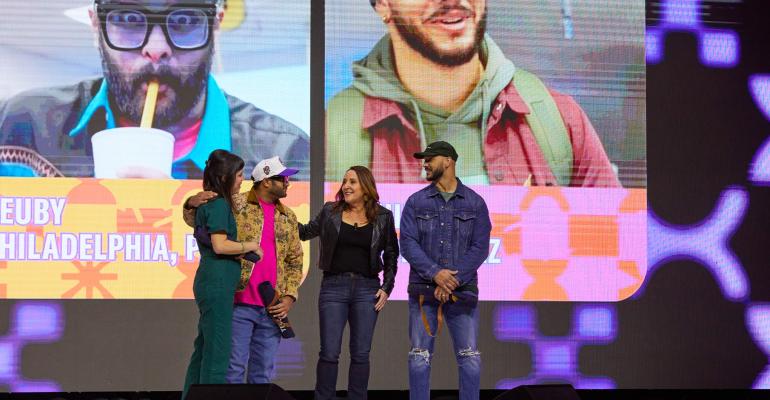Last year, Big Chicken CEO Josh Halpern predicted that in five years, consumers will be curating restaurant brands more.
“Younger generations … they want to be a part of the decision-making process. They’re making a conscious decision to attach their personal brand to our brands. It’s a collaboration now,” he said.
His five-year prediction seems to be ahead of schedule, as restaurant brands appear to be entering a “co-creator era.”
What does it mean to co-create? Well, the concept seems to be dynamic in this industry. There are the influencers tapped to co-create content for restaurant brands, for instance. There are also chefs chosen to co-create menu items for restaurant brands. And there are the fans themselves, invited to help make critical business decisions for restaurant brands, just as Halpern prognosticated.
Content seems to be the biggest piece of this puzzle and it continues to grow. In 2023, the creator economy became a $250 billion industry, and Goldman Sachs predicts it will reach about $480 million by 2027. A new survey from Morning Consult shows that nearly 90% of people ages 13 to 38 are willing to try out “influencing,” and 12% consider themselves to be actual influencers. With the visual and social nature of restaurants providing a compelling backdrop, food and beverage brands are more likely to attract creators than other industries, according to CreatorIQ.
As such, plenty of restaurant brands are embracing the trend. As Grace Chao-Isaacs, Pei Wei’s social media specialist, recently told me, “Influencers work.
“People want to feel like they are talking to a person, and we are more likely to listen to an advocate for a brand than a brand promoting their own agenda,” she said. “We want to feel like we are talking to someone about what we are viewing.”
When it comes to influencers, we’re not talking about just celebrities, like the wildly successful Travis Scott or Cactus Plant Flea Market collaborations from McDonald’s, or Taco Bell’s Doja Cat partnership to bring back the Mexican Pizza. We’re talking about local influencers with less than 5,000 followers as well. The idea of content co-creation can potentially level the brand awareness playing field for smaller restaurant concepts.
And, we’re also talking about fans themselves, versus influencers. This is the strategy McDonald’s has been embracing since Tariq Hassan was named CMO in 2021. At the time, he said the company’s “biggest unlock was moving from talking brand to fan to truly talking fan to fan.” The company started encouraging customers to make new food creations as an example and, just this week, introduced “WcDonald’s,” a digital version of McDonald’s created as an homage to the brand’s presence in mangas and anime. The campaign is part of Hassan’s philosophy to “share the pen” with fans.
Taco Bell also placed a big bet on its fans with its recent Live Más Live Live event in Las Vegas. The event included about 300 attendees, most of whom were top tier rewards members and who were sharing real-time updates on their social media accounts. As it turns out, that word-of-mouth – and FOMO effect – spreads fast if you just provide exclusive access for your biggest brand ambassadors.
Of course, Taco Bell is no stranger to pulling fans into the decision-making process. Last year, the chain sought customers’ input to curate what sayings will be included on its signature hot sauce packets, which are rolling out with a redesign this year. At the time, CMO Taylor Montgomery said, “There’s no better way to foster brand love than by giving our biggest fans a unique opportunity to leave their own mark on and be a part of Taco Bell history.”
The company has also solicited fans’ votes for menu item appearances in 2022 and 2023, and also brought back its Volcano Menu and its Mexican Pizza after fans asked for their return via petitions and social media. The Mexican Pizza’s return helped drive an 11% increase in same-store sales, by the way, so collaborative decision making with fans seems to work.
Where this trend toward co-creation becomes really interesting is when it involves the menu. White Castle recently partnered with gaming YouTuber Captain Puffy to create a new drink – the Sprite Puffy Mix – available exclusively at its restaurants, for instance. In a statement at the time, White Castle VP Jamie Richardson said the offering gave the brand an opportunity to connect with fans in a new way and “helps us reach them where they are.”
Chipotle experienced a massive tailwind when it began featuring creations from TikTok creators Keith Lee and Alexis Frost on its menu last year. The “Keithadilla” and “Fajita Quesadilla Hack” helped the company generate some of its strongest digital sales days after the launch.
Of course, reach and sales are pretty sexy incentives for restaurant brands to embrace such menu input, but so too are reputational benefits. Consider Taco Bell’s new TBX program as an example here. The company brought in three emerging chefs to help reimagine its signature Crunchwrap Supreme and will feature their creations on menus later this year. The inaugural participants have each contemplated what this opportunity could mean for their careers, all of which are already successful in their own right. But they also very much identify the opportunity for Taco Bell to cultivate a deeper relationship with fans who are craving as much.
“This program makes (Taco Bell) feel accessible to the consumer, like there’s no more line in the sand between company and consumer,” said Jennifer Hwa Dobbertin, who is one of the inaugural chefs.
“I think it’s going to resonate more and is much more of a humble approach, like ‘hey we’re supporting these creative innovators while also innovating ourselves.’ It shows that the brand is connected and a part of culture,” Chef Lawrence Smith added. “I think it’s going to bridge that gap between company and consumer.”
Contact Alicia Kelso at [email protected]





